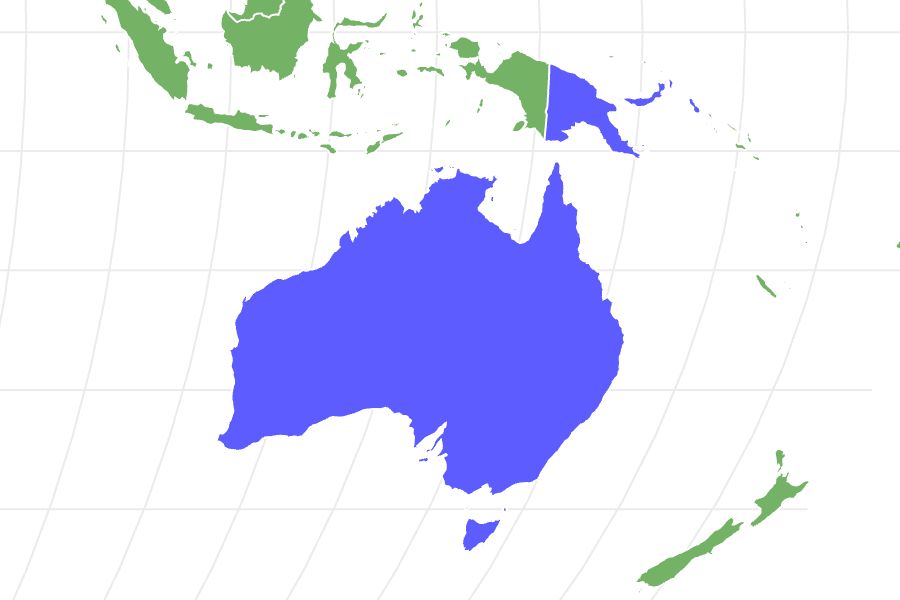Cassowary
Casuarius spp.
They can jump 7 feet in the air from a standing position!
Advertisement
Cassowary Scientific Classification
- Kingdom
- Animalia
- Phylum
- Chordata
- Class
- Aves
- Order
- Casuariiformes
- Family
- Casuariidae
- Genus
- Casuarius
- Scientific Name
- Casuarius spp.
Read our Complete Guide to Classification of Animals.
Cassowary Conservation Status
Cassowary Facts
- Main Prey
- Fruits, insects, grass, fungi
- Fun Fact
- They can jump 7 feet in the air from a standing position!
- Distinctive Feature
- Sharp claws and horn-like crest
- Incubation Period
- 49-52 days
- Habitat
- Wet tropical forests
- Predators
- Dingoes, crocodiles, humans
- Diet
- Omnivore
- Lifestyle
- Solitary
- Type
- Bird
- Average Clutch Size
- 5
- Slogan
- Can reach speeds of 30 mph!
- Nesting Location
- Ground
- Age of Molting
- 9 months
View all of the Cassowary images!
Though it’s true these birds will attack humans, they seem to only do so when they’re provoked, frightened, defending eggs or chicks, or under attack themselves.
The cassowary is a type of ratite, which is a long-legged, usually large, flightless bird. Its wings are nearly vestigial and only have a few quills. The feathers of the cassowary are coarse, and some of them contain filaments that are hair-like. Because of this, the cassowary was hunted and raised for its feathers. Females are bigger than males, and the bright colors of their heads and necks are more vivid. Even more striking is the knifelike claw on the inner toe of each foot, which are at least as formidable as the talons of the most powerful bird of prey.
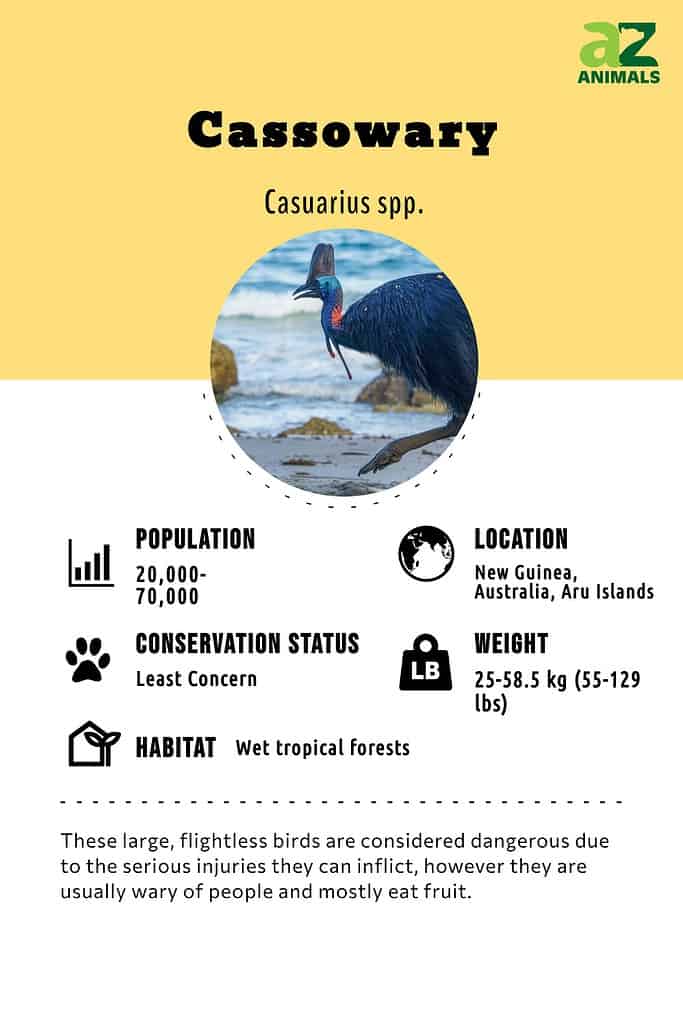
5 Amazing Cassowary Facts!
- The male bird raises the chicks, and he is especially dangerous in parent mode. He won’t hesitate to use his claws on predators and other threats.
- The female mates with two or three males in a season. She lays her eggs in their nest after mating, then moves on.
- Biologists once believed cassowaries used the hard casques located on the top of their heads to push through the undergrowth in their rainforest habitat, but now they’re not so sure of the casques’ function.
- The bird has a wide range of vocalizations, including booms, hisses, rumbles, and roars.
- A dinosaur closely resembling a cassowary was recently discovered! The two species aren’t directly related, although as cassowary relatives first evolved 60 million years ago they have ancient traits found in few animals today.
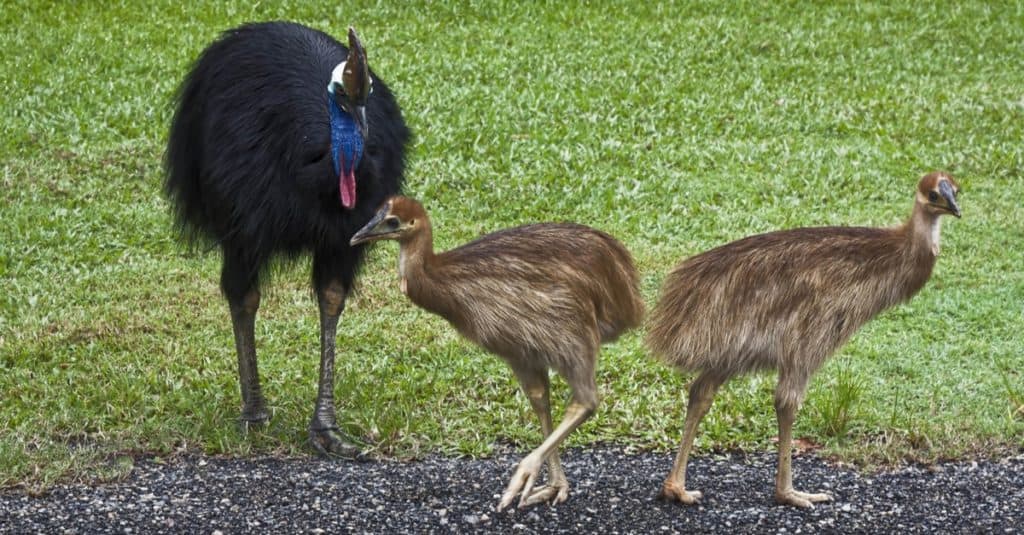
The male cassowary raises the chicks and won’t hesitate to protect them from predators.
©electra/Shutterstock.com
Scientific Name
Cassowaries belong to the genus Casuarius. Casuarius is from two Papuan words with “kasu” meaning horned and “weri” translating to head.
This refers to the bird’s casque, a hollow horn-shaped structure made of keratin affixed to the top of its head. While scientists initially thought the casque was used to help them move through their dense habitat, it’s now believed it serves other functions such as for defensive purposes in territory disputes, a secondary sexual characteristic, a way to regulate its temperature, or to amplify the low-frequency sounds that cassowaries use to communicate.
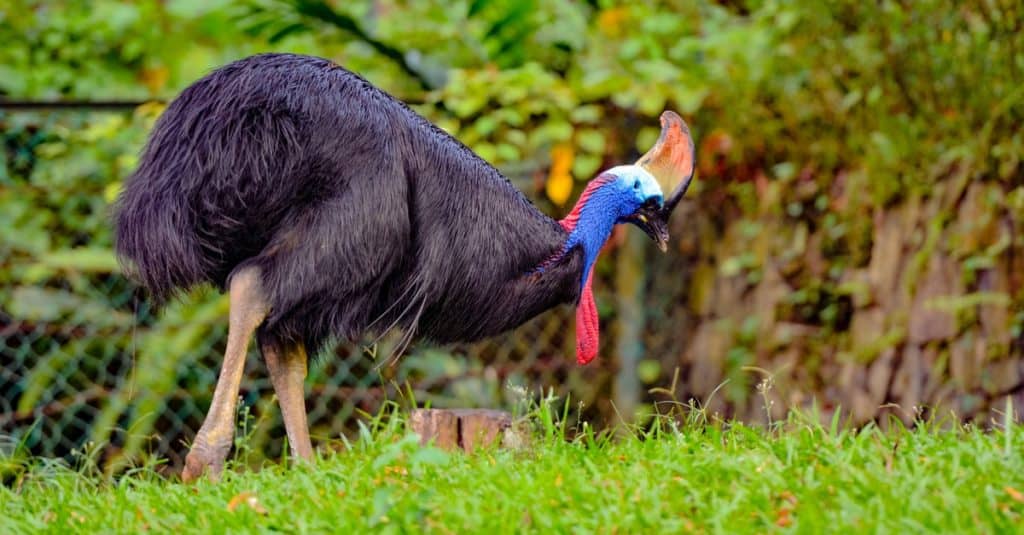
The cassowary belongs to the genus
Casuarius.
©HAFIZULLAHYATIM/Shutterstock.com
3 Types of Cassowaries
There are three species of cassowaries. They are:
- Southern cassowary (Casuarius casuarius): The southern cassowary, or double-wattled cassowary. is the largest of the species and the third-largest bird in the world after its cousin the emu and the ostrich. It can be found in southern New Guinea, Australia’s northeastern regions, and the lowlands of the Aru Islands.
- Northern cassowary (Casuarius unappendiculatus): Also called the single-wattled cassowary because it has only one wattle as compared to the southern cassowary’s two. It lives in northern New Guinea’s coastal swamplands and lowland rainforests. Populations are also found on the islands of Waigeo, Batanta, Yapen, and Salawati.
- Dwarf cassowary (Casuarius bennetti): This smaller species is also known as Bennett’s cassowary after the scientist George Bennett, who examined the bird and realized it was a new species of cassowary. It is present in New Guinea, Yapen Island, and New Britain in higher elevations than the northern or southern cassowaries.
There was a fourth species, the pygmy cassowary or small cassowary (Casuarius lydekkeri) but it is extinct. Some subspecies of the extant birds have been suggested but none have been confirmed.
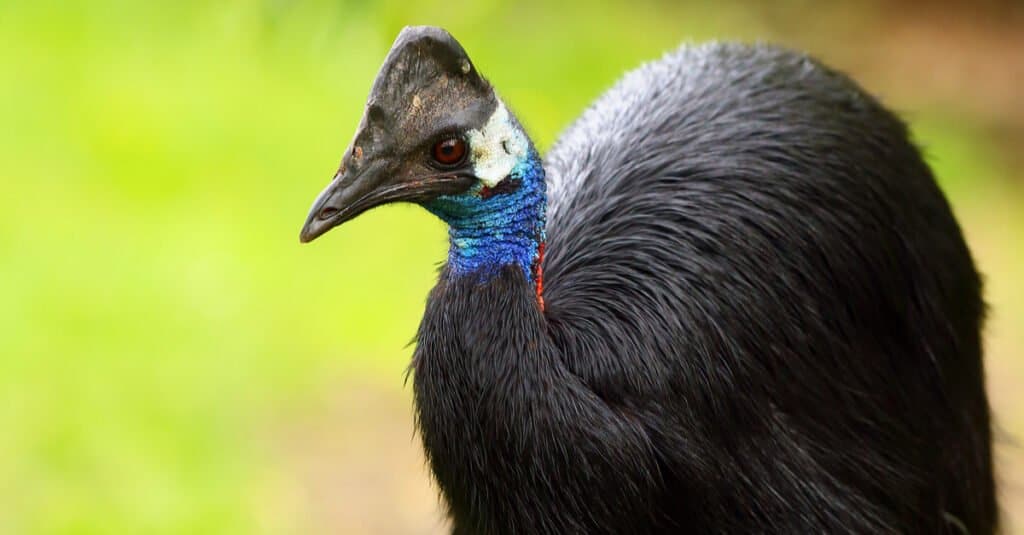
The dwarf cassowary is one of three species of cassowary.
©Karel Bartik/Shutterstock.com
Evolution and Origins
The cassowary is one of the closest extant relatives of dinosaurs and its descendants are believed to have evolved following the dinosaurs’ extinction around 60 million years ago. Scientific research published in 2017 revealed that a new dinosaur species named Corythoraptor jacobsi looked very much like the cassowary due to the crest on its skull.
Cassowaries are ratites and one of 60 flightless bird species, which includes the emu, kiwi, the extinct moa, and the extinct elephant bird that lived in Madagascar during the Pleistocene (2.58 million years to 11,700 years ago) and Holocene (11,650 years ago to the present).
Fossil evidence of the extinct pygmy cassowary species found in the Australian state of New South Wales and in Papua New Guinea dates to the Pleistocene.
Researchers determined in a 2021 study that early humans in the Late Pleistocene epoch (between 129,000 and 11,700 years ago) harvested and ate the cassowary’s eggs. Examining egg fragments from 6,000 to 18,000 years old found in the rainforests of New Guinea, they realized that many fragments had been burned and broken before the birds’ natural hatching stages, suggesting that humans were disrupting the maturity process likely to use the eggs as a food source. Scientists believe it could be possible that these people kept cassowaries as pets and raised them for their eggs much like we do chickens.
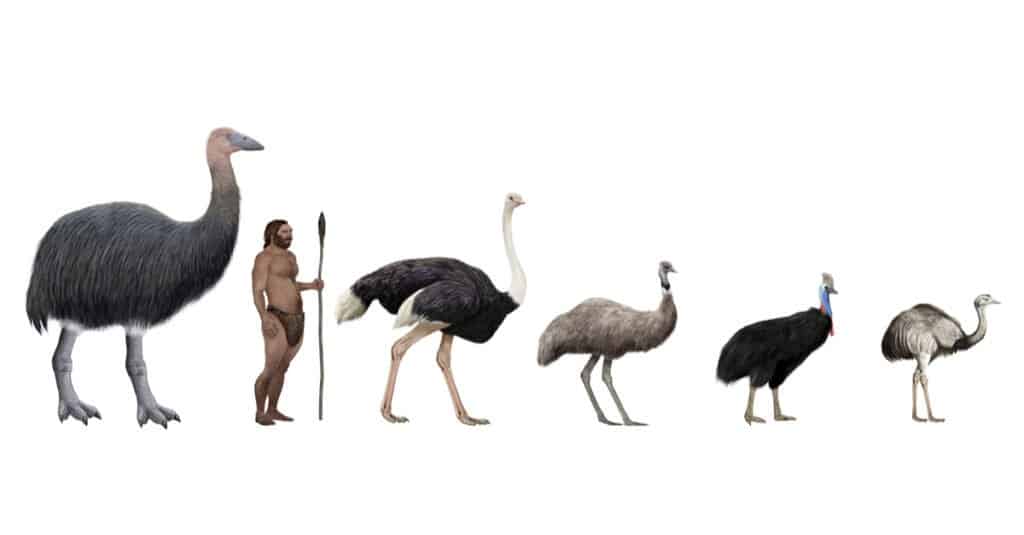
The cassowary is one flightless bird species ranging from the
elephant
bird to the emu.
©Nicolas Primola/Shutterstock.com
Appearance
The southern cassowary can grow between 40 to 72 inches in length, 75 inches in height, and 187 pounds in weight. Its head is topped with a horny casque that grows to between 5 and 7 inches tall and grows with the bird. It is possible to estimate the age of a grown bird by the size of its casque. The bird has a bright blue head and a red neck that bears two red wattles. Each long, scaly leg ends in a three-toed foot whose inner toe bears that lethal claw, which can be 4.7 inches long.
The northern cassowary is known for its orange-gold or red neck and single wattle. It is built along the same lines as the southern cassowary, but is a bit smaller in height and lighter in weight, with the females weighing about 128 pounds.
As its name suggests, the dwarf cassowary is the smallest species, but it is not small. Physical features include a body that’s 3 to 5 feet long and 39 to 53 inches in height. It weighs between 39 and 57 pounds. Its triangular casque is smaller than those of the northern and southern cassowaries in proportion to its body. It has a bright blue and red neck and pink cheeks.
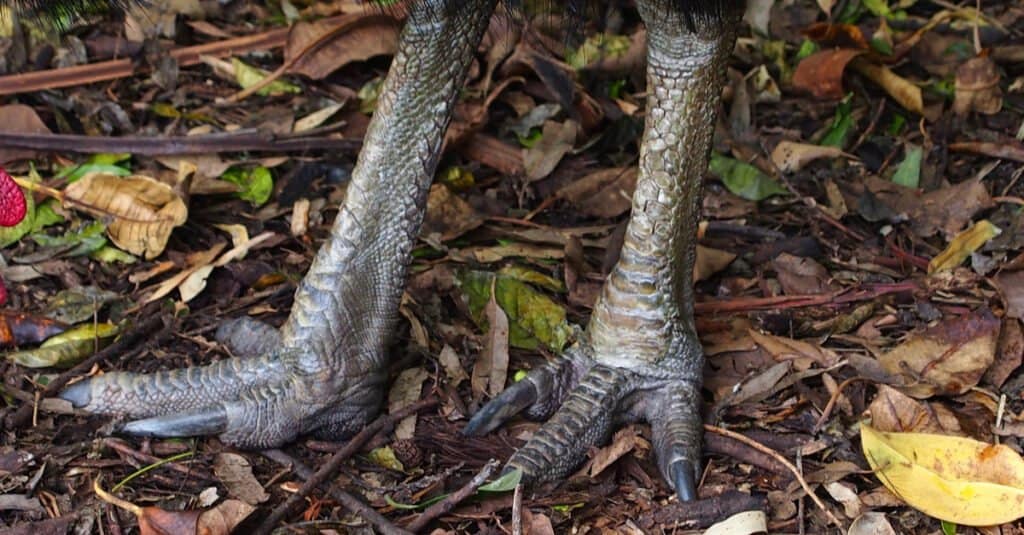
The cassowary has three-toed feet with the inner toe bearing a lethal claw.
©Andreas Ruhz/Shutterstock.com
Behavior
Cassowaries can jump 7 feet in the air from a standstill and run up to 31 mph.
The southern cassowary is shy and solitary and will chase other cassowaries away except during the mating season.
Despite that famous claw, it is not used to grab prey the way raptors use their talons.
Though it is true that these birds will attack humans, they seem to only do so when they’re provoked, frightened, defending eggs or chicks, or under attack themselves. Some cassowaries associate humans with food and will simply jump at a human in expectation of a meal.
Cassowaries have been called “the most dangerous birds in the world” by publications such as The Guinness Book of World Records. That claim comes in part because there have been two recorded human fatalities and more than 200 incidents with cassowaries.
Overall, cassowary attacks are rare. Most have come because people tried feeding cassowaries, and most incidents involve the birds charging. However, in the event that a person falls to the ground cassowaries can be quite dangerous. Their dagger-like claws can grow up to 5 inches and cause severe wounds or even death.
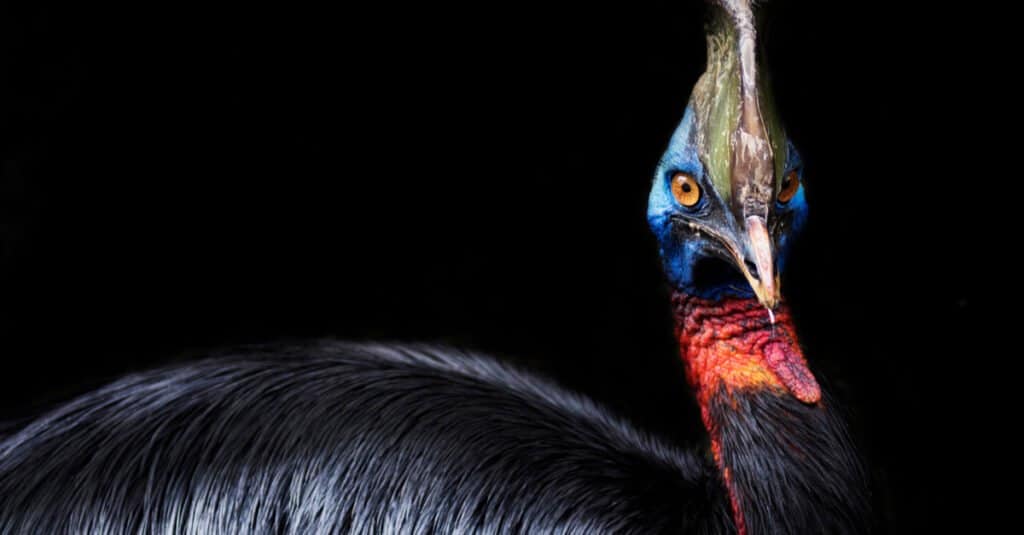
Cassowaries have been called the most dangerous birds in the world.
©Sardo Michael/Shutterstock.com
Habitat
These birds are found in New Guinea — which includes Papua New Guinea, Indonesia, and Seram, an island that is part of Indonesia — as well as the northeastern part of Australia, and the Aru Islands that lie between New Guinea and Australia.
Though they are large birds, they are secretive and hard to find in their tropical rainforest habitats. They are known to live in the Paluma Range National Park, the McIlwraith Range National Park, and the Jardine River National Park in Australia.
Fortunately, there are a number of zoos around the world that exhibit cassowaries. Among them are:
- The San Diego Zoo
- The Edinburgh Zoo
- The Denver Zoo
- The Perth Zoo
- The National Zoo
- The Natural Bridge Zoo
- The Los Angeles Zoo.
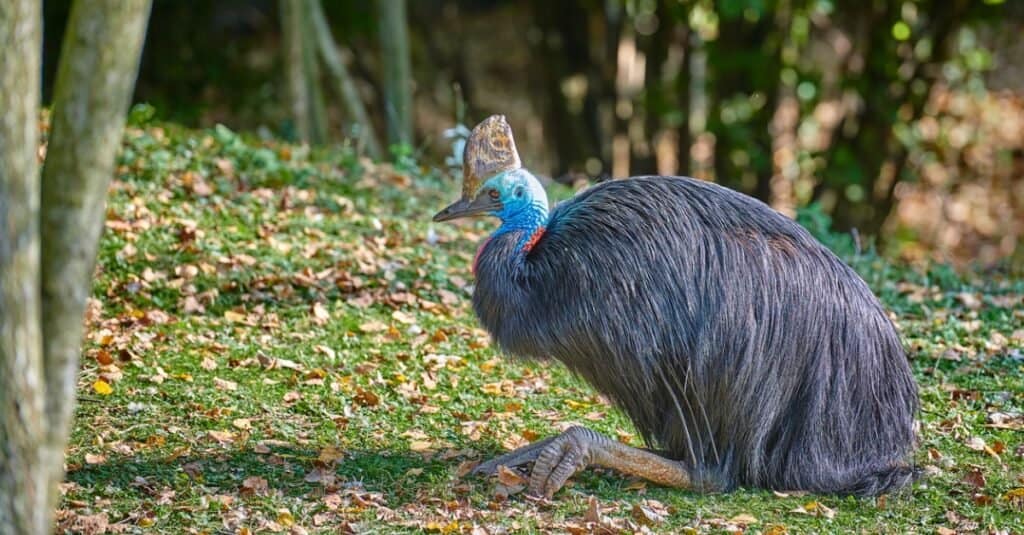
Cassowaries make their homes in tropical rainforests.
©iStock.com/DannyIacob
Diet
The cassowary eats fruit that has fallen to the ground, berries, mushrooms and other fungi, plant materials, and small vertebrates like lizards. It is capable of eating plant matter that will poison other animals because food goes through their digestive system very quickly. They’ll also eat small reptiles and amphibians, rats and mice, snails, and insects.
They will also eat carrion, and babies eat the feces of their fathers and siblings. Indeed, grown birds are known to eat their own feces if they still have undigested fruit.
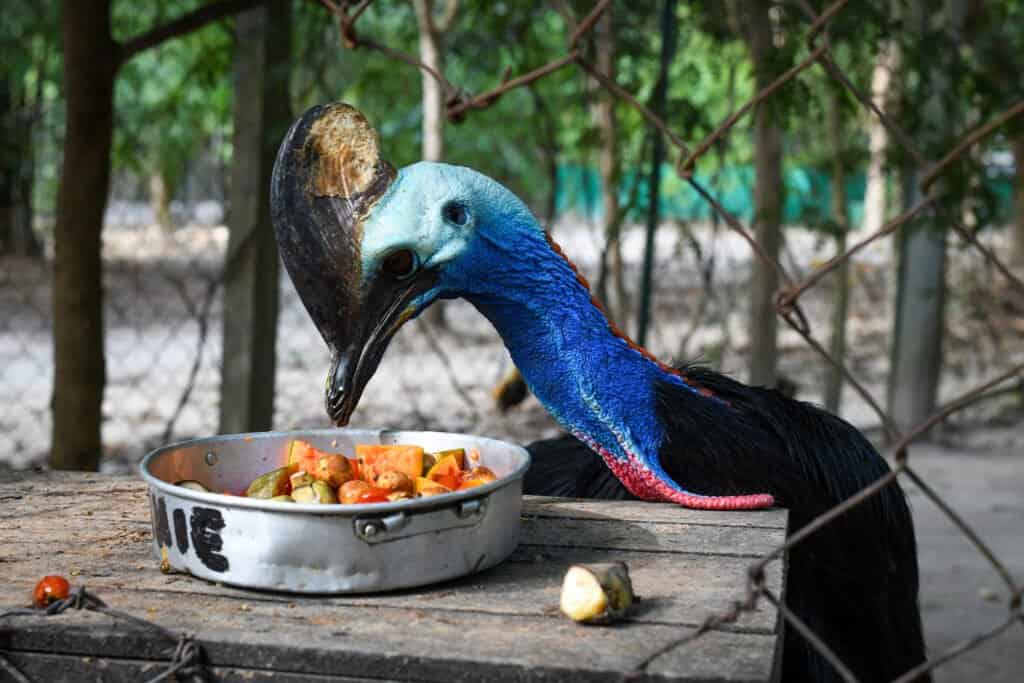
The cassowary’s diet includes fruits, berries, and plant material.
©Pongpol Teinpothong/Shutterstock.com
Predators and Threats
The biggest threat to these birds is humans. Humans kill them for their meat and their feathers and inadvertently kill them on the highways.
Their chicks, which drop at a sign of danger, are eaten by dogs and pigs. Pigs also eat their eggs, and the cassowary’s habitat has been fragmented and destroyed by logging and development.
Other things that threaten cassowaries are diseases and natural disasters such as typhoons.
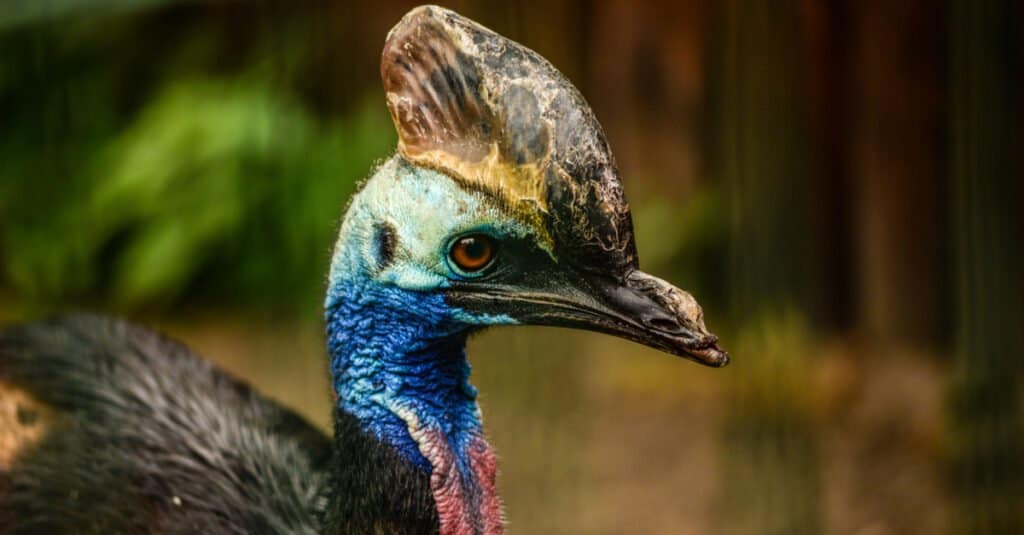
The cassowary is at risk from humans, diseases, and environmental damage.
©studioxy/Shutterstock.com
Reproduction, Babies, and Lifespan
The breeding season for cassowaries occurs in winter and spring. Males will claim a territory and build a nest upon fallen leaves on the ground that is shallow but sometimes lined with leaves or grass. The male will court a female by vocalizing and inflating his throat and dancing while she watches. If she accepts him and doesn’t drive him off, she’ll sit on the ground, and they’ll mate. She will then lay four to six green eggs in his nest, with the color due to a pigment called biliverdin found in the shells and providing camouflage. When she’s done, he’ll chase her off and incubate the eggs himself for about 47 to 56 days. In the meantime, the female will find another male. She’ll lay as many as 20 eggs before she’s through.
Baby cassowaries stay with their fathers for nine months or until their first molt, though they will be three years old before they have grown-up plumage. Some chicks stay with their fathers for as long as 18 months. The baby cassowaries are covered with brown down with black streaks. The father becomes very aggressive if he feels the chicks are under threat from predators.
Female cassowaries are sexually mature when they are two, and males are mature when they are three. After that, they are able to reproduce for decades. Females can breed until they’re about 40, and males until they’re about 35. The oldest cassowary known lived to be at least 61 years old.
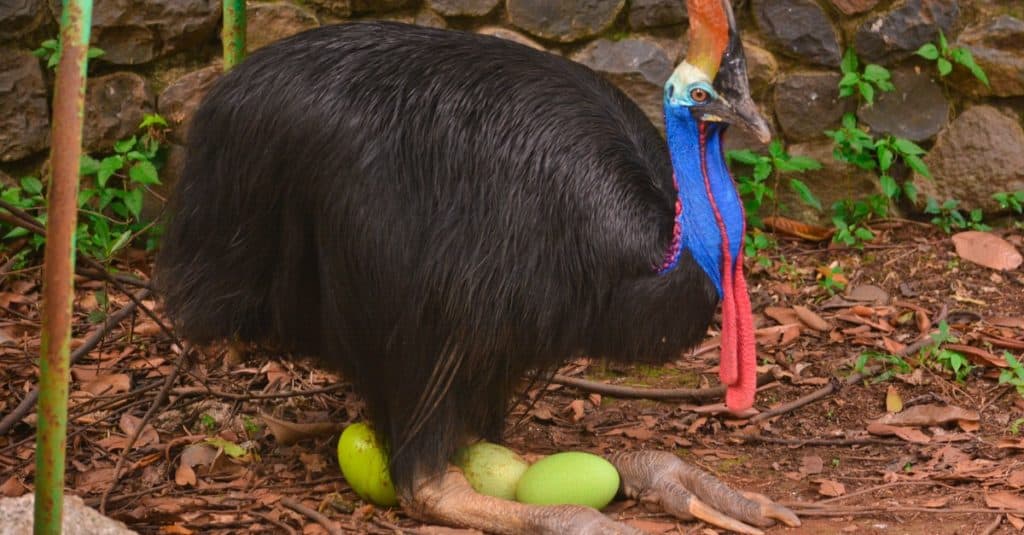
Once the female lays 4-6 green eggs, the male will chase her off and incubate the eggs.
©lucky vectorstudio/Shutterstock.com
Population and Conservation
Scientists aren’t completely sure how many cassowaries are in the wild, but the status of all species according to the IUCN Red List of Threatened Species is of Least Concern.
There are an estimated 20,000 to 50,000 southern cassowaries and up to 20,000 northern cassowaries. The population of the dwarf cassowary is unknown. The populations of all three species are declining.
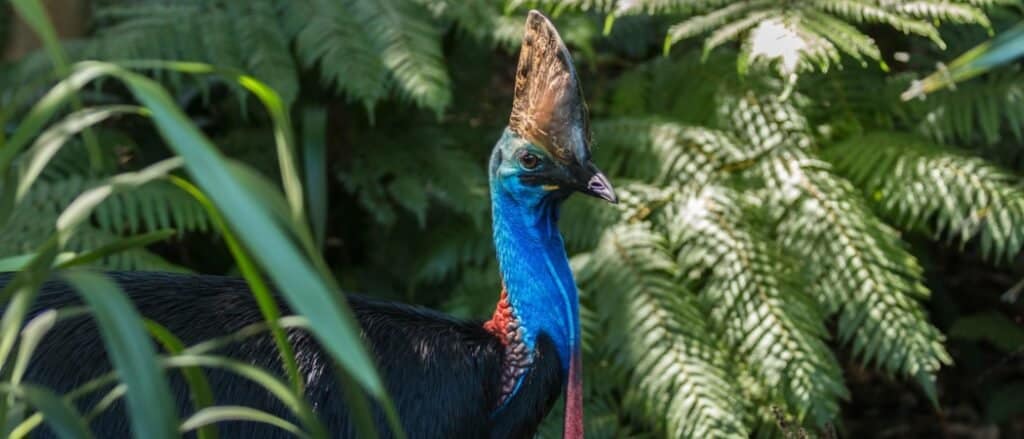
The cassowary’s conservation status is classified as Least Concern.
©iStock.com/picassos
Cassowary FAQs (Frequently Asked Questions)
Are cassowaries herbivores, carnivores, or omnivores?
Cassowaries are omnivores, meaning they eat both plants and other animals.
What kingdom do cassowaries belong to?
Cassowaries belong to the kingdom Animalia.
What phylum to cassowaries belong to?
Cassowaries belong to the phylum Chordata.
What family do cassowaries belong to?
Cassowaries belong to the family Casuariidae.
What order do cassowaries belong to?
Cassowaries belong to the order Casuariiformes.
What genus do cassowaries belong to?
Cassowaries belong to the genus Casuarius.
What type of covering do cassowaries have?
Cassowaries are covered in feathers.
In what type of habitat do cassowaries live?
Cassowaries live in wet tropical forests.
What is the main prey for cassowaries?
Cassowaries eat fruits, insects, grass, and fungi.
What are some predators of cassowaries?
Predators of cassowaries include dingos, crocodiles, and humans.
What are some distinguishing features of cassowaries?
Cassowaries have sharp claws and horn-like crests.
How many eggs do cassowaries lay?
A cassowary lays between four to six green eggs. The eggs are bright green at first, then fade.
What is an interesting fact about cassowaries?
Cassowaries can reach speeds of 30 mph!
What is the scientific name for the cassowary?
The scientific name for the cassowary is Casuarius spp.
What is the lifespan of a cassowary?
Cassowaries can live for 40 to 60 years.
What is the cassowary's wingspan?
The cassowary has a wingspan of 1.5-2 m (59-79 in).
How fast is a cassowary?
A cassowary can travel at speeds of up to 31 miles per hour.
Does the cassowary migrate?
Cassowaries don’t migrate.
How fast does the cassowary fly?
A cassowary doesn’t fly, but it can run 31 miles an hour, and jump 5 feet in the air.
When do cassowaries leave the nest?
Cassowary chicks leave the nest very soon after they hatch because they are precocial, but their father takes care of them for at least nine months.
Why is the cassowary so dangerous?
The cassowary is dangerous because, though it lacks talons like other birds, each foot has a claw like a dagger, and if the bird is threatened it may attack. Even if it doesn’t use the claws, a bird that weighs as much as a grown-up human can cause damage if it jumps on you, and its kick is powerful enough to break bones.
Can a cassowary kill you?
Unfortunately, cassowaries have been known to kill people.
Is a cassowary a dinosaur?
Being a bird, a cassowary can be thought of as a type of modern dinosaur.
What to do if you see a cassowary?
If you see a cassowary and are afraid it’s going to attack, back away slowly, and put something between you and the bird, such as a tree or a backpack.
Who would win in a fight between a cassowary and a Komodo dragon?
A Komodo dragon would win in a fight against a cassowary, despite it being the world’s deadliest bird. However, there is a good chance that a cassowary would escape before being defeated.
What are the key differences between an emu and a cassowary?
The key differences between an emu and a cassowary are appearance, range, habitat, and group behavior.
What are the key differences between an ostrich and a cassowary?
The key differences between a cassowary and an ostrich are the size, appearance, range, and social structure.
How to say Cassowary in ...
Thank you for reading! Have some feedback for us? Contact the AZ Animals editorial team.
Sources
- Nature, Available here: https://www.nature.com/news/1999/991223/full/news992123-2.html
- Queensland Government Department of Environment and Science, Available here: https://environment.des.qld.gov.au/wildlife/threatened-species/featured-threatened-species-projects/cassowary
- Wikipedia, Available here: https://en.wikipedia.org/wiki/Cassowary
- Animal Diversity Web, Available here: https://animaldiversity.org/accounts/Casuariidae/

